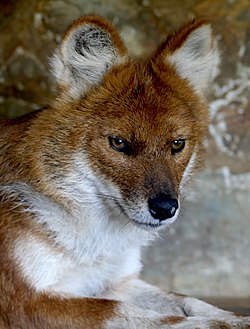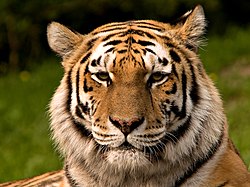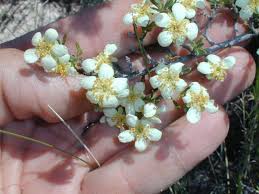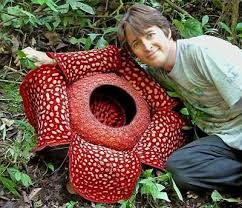 dhole
dhole Siberian tiger
Siberian tigerAn endangered species is a population of organisms which is at risk of becoming extinct because it is either few in numbers, or threatened by changing environmental or predation parameters. Also it could mean that due to deforestation there may be a lack of food and/or water. The International Union for Conservation of Nature (IUCN) has calculated the percentage of endangered species as 40 percent of all organisms based on the sample of species that have been evaluated through 2006. (Note: the IUCN groups all threatened species for their summary purposes.) Many nations have laws offering protection to conservation reliant species: for example, forbidding hunting, restricting land development or creating preserves. Only a few of the many species at risk of extinction actually make it to the lists and obtain legal protection. Many more species become extinct, or potentially will become extinct, without gaining public notice.
Impact on biodiversity and endangered species
In order to conserve the biodiversity of the planet, one must take into consideration the reasons why so many species are becoming endangered. “Habitat loss is the most widespread cause of species endangerment in the U.S., affecting 85% of imperiled species” (Wilcove & Master, 2008, p. 416). When an animal’s ecosystem is not maintained, they lose their home and are either forced to adapt to new surroundings or perish. Pollution is another factor that causes many species to become endangered, especially a large proportion of aquatic life. Also, over-exploitation, disease (Wilcove & Master, 2008, p. 416), and climate change (Kotiaho et al., 2005, p. 1963) have led to the endangerment of several species.
However, the most important factor leading to the endangerment of the majority of wildlife in the world is the human impact on the species and their environment. “As human use of resources, energy, and space intensified over the past few centuries, the diversity of life has been substantially diminished in most parts of the world” (Ishwaran & Erdelen, 2006, p.179). Basically, as the human impact on the environment increases, the diversity of life decreases. Humans are constantly using the resources and space of other species for themselves, negatively impacting the survival rate of many creatures.
Humans also set standards for which species they think should be saved and which species they find unimportant or undesirable. For example, the coqui frog, an invasive species in Hawaii, is so common there that its “nocturnal singing” reduces the value of homes and prevents hotels from using rooms near forests. Hawaiians have proposed eliminating the frog, and several wildlife managers want to release a pathogen to kill the frogs (Minteer & Collins, 2005, p. 333). The frog has decreased the value of homes and caused a loss of business for several hotels, so the Hawaiians decided it was acceptable to get rid of the group of coqui frog living near them.
Another example where the human impact affected the welfare of a species sex in the instance of non-native mute swans establishing themselves at Arrowhead Lake in Vermont. When the population of swans grew to eight birds, the Vermont Fish and Wildlife Department decided to take action. Two swans were eventually killed, angering animal welfare organizations and people living near the lake (Minteer & Collins, 2005, p. 333). The case of the Arrowhead Lake swans demonstrates what one considers the natural environment based on human assumptions. Simply because the swans were not normally living there does not mean it is not part of their natural habitat, and there is certainly no reason for them to be destroyed because of human dissatisfaction.
Yet another example of the human impact in the lives of endangered species is that of the Preble’s meadow jumping mouse. Research has shown that the mouse is not taxonomically different from the Bear Lodge meadow jumping mouse and the US Fish and Wildlife Service has proposed removing the Preble’s mouse from the endangered species list based on this information (Minteer & Collins, 2005, p. 333).
A final example of the human impact on existing species is the issue of toe clipping in ecological research. While ecologists are doing research on different species to advance their knowledge of methods of conservation, they must take into consideration the impact they have on the wildlife they are studying. Toe clipping “has been reported to result in a number of adverse effects on the animals, including inflammation and infection of the feet and limbs” (Minteer & Collins, 2005, p. 334). This example demonstrates how humans must take into consideration the well-being of the animal even before they perform research to help conserve the species. The human impact on species and their environments has many negative effects. It is important for humans to help maintain all species in the world and not deter their development.
Species maintaining importance
“Diversity of life and living systems are a necessary condition for human development” (Ishwaran & Erdelen, 2006, p.179). Many question the importance of maintaining biodiversity in today’s world, where conservation efforts prove costly and time consuming. The fact is that the preservation of all species is necessary for human survival. Species should be saved for “aesthetic and moral justifications; the importance of wild species as providers of products and services essential to human welfare; the value of particular species as indicators of environmental health or as keystone species crucial to the functioning of ecosystems; and the scientific breakthroughs that have come from the study of wild organisms” (Wilcove & Master, 2008, p. 418). In other words, species serve as a source of art and entertainment, provide products such as medicine for human well-being, indicate the welfare of the overall environment and ecosystem, and provided research that resulted in scientific discoveries. An example of an “aesthetic justification” in conserving endangered species is that of the introduction of the gray wolf into Yellowstone National Park. The gray wolf has brought numerous amounts of tourists to the park and added to the biodiversity in the protected region (Wilcove & Master, 2008, p. 418).
Another example, supporting the conservation of endangered species as providers of products for human well-being, is the scrub mint. It has been found that the scrub mint contains an anti-fungal agent and a natural insecticide (Wilcove & Master, 2008, p. 418). Also, the deterioration of the bald eagle and the peregrine falcon “alerted people to the potential health hazards associated with the widespread spraying of DDT and other persistent pesticides” (Wilcove & Master, 2008, p. 418).
Helping preserve endangered species
It is the goal of conservationists to create and expand upon ways to preserve endangered species and maintain biodiversity. There are several ways in which one can aid in preserving the world’s species who are nearing extinction. One such way is obtaining more information on different groups of species, especially invertebrates, fungi, and marine organisms, where sufficient data is lacking.
For example, to understand the causes of population declines and extinction an experiment was conducted on the butterfly population in Finland. In this analysis, the butterflies’ endangered list classification, distribution, density, larval specificity, dispersal ability, adult habitat breadth, flight period and body size were all recorded and examined to determine the threatened state of each species. It was found that the butterflies’ distribution has declined by fifty-one and a half percent, and they have a severely restricted habitat. One example of specific butterflies who have a declining distribution rate are the Frigga’s Fritillary and Grizzled Skipper, who have been affected by habitat loss due to extensive draining of the bogs where they live (Kotiaho et al., 2005, p. 1963-1967). This experiment proves that when we know the causes of endangerment, we can successfully create solutions for the management of biodiversity.
Another way to help preserve endangered species is to create a new professional society dedicated to ecological ethics. This could help ecologists make ethical decisions in their research and management of biodiversity. Also, creating more awareness on environmental ethics can help encourage species preservation. “Courses in ethics for students, and training programs for ecologists and biodiversity managers” all could create environmental awareness and prevent violations of ethics in research and management (Minteer & Collins, 2005, p. 336). One final way in which one can conserve endangered species is through federal agency investments and protection enacted by the federal government. “Ecologists have proposed biological corridors, biosphere reserves, ecosystem management, and ecoregional planning as approaches to integrate biodiversity conservation and socioeconomic development at increasingly larger spatial scales” (Ishwaran & Erdelen, 2006, p.179).
One example of a federal mandated conservation zone is the Northwest Hawaiian Islands Marine National Monument, the largest marine protected area in the world. The monument is essential to the preservation of underwater communities and overfished regions. Only researchers working in the area are permitted to fish, no corals may be removed, and the Department of Homeland Security will enforce restrictions on vessels passing through the waters via satellite imaging. The monument will serve as a home to an estimated seven thousand species, most of which cannot be found anywhere else in the world (Raloff, 2006, p. 92). This environmental monument demonstrates the fact that it is possible to create a safe environment for endangered species, as well as maintaining some of the world’s largest ecosystems.
Captive breeding programs
Captive breeding is the process of breeding rare or endangered species in human controlled environments with restricted settings, such as wildlife preserves, zoos and other conservation facilities. Captive breeding is meant to save species from going extinct. It is supposed to stabilize the population of the species so it is no longer at risk for disappearing.
This technique has been used with success for many species for some time, with probably the oldest known such instances of captive mating being attributed to menageries of European and Asian rulers, a case in point being the Pere David's Deer. However, captive breeding techniques are usually difficult to implement for highly mobile species like some migratory birds (eg. cranes) and fishes (eg. Hilsa). Additionally, if the captive breeding population is too small, inbreeding may occur due to a reduced gene pool; this may lead to the population lacking immunity to diseases.
Legal private farming for profit
Whereas poaching causes substantial reductions in endangered animal populations, legal private farming for profit has the opposite effect. Legal private farming has caused substantial increases in the populations of both the southern black rhinoceros and the southern white rhinoceros. Dr Richard Emslie, a scientific officer at the IUCN, said of such programs, "Effective law enforcement has become much easier now that the animals are largely privately owned... We have been able to bring local communities into the conservation programmes. There are increasingly strong economic incentives attached to looking after rhinos rather than simply poaching: from eco-tourism or selling them on for a profit. So many owners are keeping them secure. The private sector has been key to helping our work. "
Conservation experts view the effect of China's turtle farming on the wild turtle populations of China and South-Eastern Asia - many of which are endangered - as "poorly understood". While they commend the gradual replacement of wild-caught turtles with farm-raised ones gradually in the marketplace ( the percentage of farm-raised individuals in the "visible" trade growing from around 30% in 2000 to around 70% ca. 2007), they are concerned with the fact that a lot of wild animals are caught to provide farmers with the breeding stock. As the conservation expert Peter Paul van Dijk noted, turtle farmers often believe in the superiority of wild-caught animals as the breeding stock, which may create an incentive for turtle hunters to seek and catch the very last remaining wild specimens of some endangered turtle species.
In 2009, researchers in Australia managed for the first time to coax southern bluefin tuna to breed in landlocked tanks, opening up the possibility of using fish farming as a way to save the species from the problems of overfishing in the wild.
Sarracenia oreophila

The Pitcher Plant has hollow leaves which hold water, which gives it its name. There are eighty kinds of pitcher plants. They are found in tropical wetlands, mostly in Malaysia, Madagascar, and Sri Lanka.
The leaves of the pitcher plant can be from two inches to more than two feet in length. Large pitcher plants can trap small frogs and mice, and small plants can catch insects. Rainwater fills the jugs of the plant. Around the lip of the pitcher, nectar is produced. This attracts flies who like the nectar. As they search farther into the jug, they slip down into it and drown. There it is digested by the plant.
People are growing carnivorous plants in indoor greenhouses. This helps preserve these fascinating plants. If they were left to grow in their natural habitat, they would be destroyed by people draining the marshlands where the plant lives to build buildings and roads.
Purshia subintegra
The Arizona Cliffrose is found in four counties in the state of Arizona: Mojave, Graham, Yavapai and Maricopa. It is a member of the Rosaceae family, which includes the rose, blackberry, and hawthorn plants.
It is an evergreen shrub that grows about 1.5 meters tall. It has white and yellow petals, and is the leaves are gray in color. It is found in limestone lakebed deposits, and is food for muledeer. People like to use them as decorative plants for their homes.
It is on the endangered species list because of the damage done to them by off-road vehicle traffic, mining, pesticides, and road construction.Venus Fly Trap
Dionaea Muscipula

The Venus Fly Trap belongs to the Doseraceae, or Sundew, family of plants. There are over 150 species. The Venus Fly Trap grows in between Florida and North and South Carolina. They grow well in acidic, boggy areas.
It is a carnivorous plant, which means it eats insects. If a fly lands on its leaves, it touches the adaxial receptors, which are small hairs on the plant. These receptors have to be touched three times before the chemical reaction occurs that makes the Venus Fly Trap close its leaves in a quick motion. The fly is then stuck in the leaf and can’t get out. The bug is then "digested" by the plant. The plant can digest things three times before it dies.
Their natural habitats are being destroyed by development in its region. If you want one, it is best to buy one from a plant nursery rather than take one from its natural habitat.
You can buy a Venus Fly Trap at big hardware chain stores, and they cost about three to five dollars. You have to transplant your plant in the spring in a peat moss mix. If you want to feed your plant, you should let it have a live bug, because the motion helps its feeding instinct.
Rafflesia
Rafflesia arnoldii is a member of the genus Rafflesia. It is noted for producing the largest individual flower on earth, and a strong odor of decaying flesh - the latter point earning it the nickname of "corpse flower". It occurs only in the rainforests of Sumatra and Borneo in the Indonesian Archipelago. Although there are some plants with larger flowering organs like the Titan Arum and Talipot palm, those are technically clusters of many flowers.
Several species of Rafflesia grow in the jungles of southeast Asia, including the Philippines. Many of them are threatened or endangered. The flower of Rafflesia arnoldii is the largest which attains a diameter of nearly one meter (3 ft) and can weigh up to 11 kilograms (24 lb).
It lives as a parasite on the Tetrastigma vine, which grows only in primary (undisturbed) rainforests. Rafflesia lacks any observable leaves, stems or even roots, yet is still considered a vascular plant. Similar to fungi, individuals grow as thread-like strands of tissue completely embedded within and in intimate contact with surrounding host cells from which nutrients and water are obtained. Perhaps the only part of Rafflesia that is identifiable as distinctly plant-like are the flowers; although, even these are unusual since they attain massive proportions, have a reddish-brown coloration and stink of rotting flesh, which is why it was nicknamed the "corpse flower". This scent attracts insects such as flies which then pollinate the rare plant. It is not to be confused with the Titan Arum, Amorphophallus titanum, which is also commonly referred to as the "corpse flower".


No comments:
Post a Comment